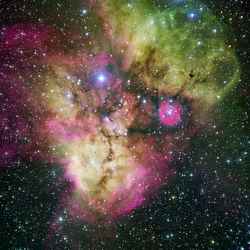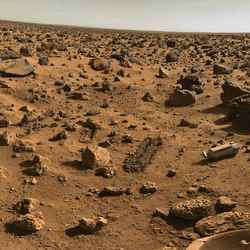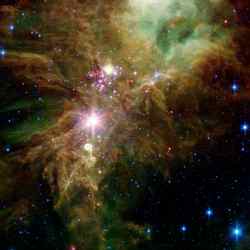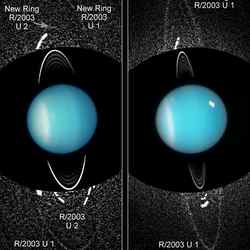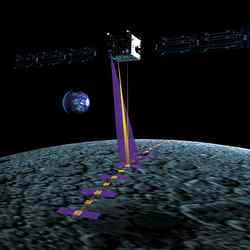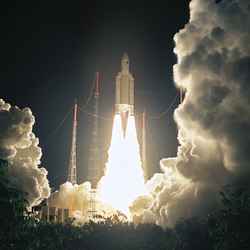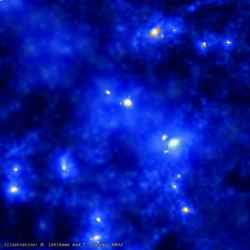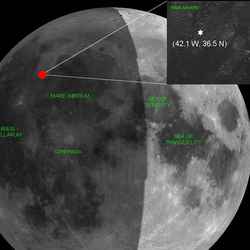
The red dot indicates the location of the recent meteoroid impact. Image credit: NASA/MSFC/Bill Cooke. Click to enlarge
NASA scientists have observed an explosion on the moon. The blast, equal in energy to about 70 kg of TNT, occurred near the edge of Mare Imbrium (the Sea of Rains) on Nov. 7, 2005, when a 12-centimeter-wide meteoroid slammed into the ground traveling 27 km/s.
“What a surprise,” says Marshall Space Flight Center (MSFC) researcher Rob Suggs, who recorded the impact’s flash. He and colleague Wes Swift were testing a new telescope and video camera they assembled to monitor the moon for meteor strikes. On their first night out, “we caught one,” says Suggs.
The object that hit the moon was “probably a Taurid,” says MSFC meteor expert Bill Cooke. In other words, it was part of the same meteor shower that peppered Earth with fireballs in late October and early November 2005. (See “Fireball Sightings” from Science@NASA.)
The moon was peppered, too, but unlike Earth, the moon has no atmosphere to intercept meteoroids and turn them into harmless streaks of light. On the moon, meteoroids hit the ground–and explode.
“The flash we saw,” says Suggs, “was about as bright as a 7th magnitude star.” That’s two and a half times dimmer than the faintest star a person can see with their unaided eye, but it was an easy catch for the group’s 10-inch telescope.
Cooke estimates that the impact gouged a crater in the moon’s surface “about 3 meters wide and 0.4 meters deep.” As moon craters go, that’s small. “Even the Hubble Space Telescope couldn’t see it,” notes Cooke. The moon is 384,400 km away. At that distance, the smallest things Hubble can distinguish are about 60 meters wide.
This isn’t the first time meteoroids have been seen hitting the moon. During the Leonid meteor storms of 1999 and 2001, amateur and professional astronomers witnessed at least half-a-dozen flashes ranging in brightness from 7th to 3rd magnitude. Many of the explosions were photographed simultaneously by widely separated observers.
Since the Leonids of 2001, astronomers have not spent much time hunting for lunar meteors. “It’s gone out of fashion,” says Suggs. But with NASA planning to return to the moon by 2018, he says, it’s time to start watching again.
There are many questions that need answering: “How often do big meteoroids strike the moon? Does this happen only during meteor showers like the Leonids and Taurids? Or can we expect strikes throughout the year from ‘sporadic meteors?'” asks Suggs. Explorers on the moon are going to want to know.
“The chance of an astronaut being directly hit by a big meteoroid is miniscule,” says Cooke. Although, he allows, the odds are not well known “because we haven’t done enough observing to gather the data we need to calculate the odds.” Furthermore, while the danger of a direct hit is almost nil for an individual astronaut, it might add up to something appreciable for an entire lunar outpost.
Of greater concern, believes Suggs, is the spray??bf?”the secondary meteoroids produced by the blast.” No one knows how far the spray reaches and exactly what form it takes.
Also, ground-shaking impacts could kick up moondust, possibly over a wide area. Moondust is electrostatically charged and notoriously clingy. (See “Mesmerized by Moondust” from Science@NASA.) Even a small amount of moondust can be a great nuisance: it gets into spacesuit joints and seals, clings to faceplates, and even makes the air smell when it is tramped indoors by moonwalkers. Could meteoroid impacts be a source of lunar “dust storms?” Another question for the future….
Suggs and his team plan to make more observations. “We’re contemplating a long-term monitoring program active not only during major meteor showers, but also at times in between. We need to develop software to find these flashes automatically,” he continues. “Staring at 4 hours of tape to find a split-second flash can get boring; this is a job for a computer.”
With improvements, their system might catch lots of lunar meteors. Says Suggs, “I’m ready for more surprises.”
Original Source: NASA News Release

